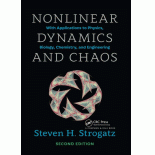
Interpretation:
To show explicitly that bead’s kinetic and potential energy is not conserved when it is in constant motion. Find the physical interpretation of the conserved quantity.
Concept Introduction:
Express the total energy by considering rotational and translation motion of the hoop and bead.
Find the derivative of the energy to determine the energy is conserved or not.
Answer to Problem 17E
Solution:
It is shown that the bead’s kinetic and potential energy is not conserved when it is in motion. The physical interpretation of the conserved quantity is stated.
Explanation of Solution
Given information:
The system is with bead and hoop in motion.
The total energy is expressed as
Here,
This energy
For the bead’s motion, the energy equation is given as,
Here
The conserved energy when
By dividing both sides by
The energy equation for the bead system is as,
By substituting
Hence the conserved energy when
We have to show that the bead’s kinetic energy and potential energy is not conserved. Consider the system with hoop and bead.
When the hoop has zero potential energy, if the bead is at the vertical height of the hoop then e
Here are the two kinetic energies, translational and rotational energy.
Considering the kinetic energy due to the rotation of bead around the vertical rotational axis of the hoop. This rotational kinetic energy depends on the horizontal distance from the rotational axis and the rotation rate of the hoop
It is given by,
Total kinetic energy is given by,
Hence total energy is given as,
To determine the conserved energy we will take the derivative with respect to
By substituting
Since
As the hoop transfer the energy to the bead when it goes away from the bottom. This hoop has a constant rotation rate and it is denoted by
For a system, the conserved quantity is the Hamiltonian denoted by
It is shown that the bead’s kinetic and potential energy is not conserved when it is in constant motion. The physical interpretation of the conserved quantity is stated.
Want to see more full solutions like this?
Chapter 6 Solutions
Nonlinear Dynamics and Chaos
- 1. Evaluate the following improper integrals: (a) fe-rt dt; (b) fert dt; (c) fi da dxarrow_forward8. Given the rate of net investment I(t) = 9t¹/2, find the level of capital formation in (i) 16 years and (ii) between the 4th and the 8th years.arrow_forward9. If the marginal revenue function of a firm in the production of output is MR = 40 - 10q² where q is the level of output, and total revenue is 120 at 3 units of output, find the total revenue function. [Hints: TR = √ MRdq]arrow_forward
- 6. Solve the following first-order linear differential equations; if an initial condition is given, definitize the arbitrary constant: (a) 2 + 12y + 2et = 0, y(0) = /; (b) dy+y=tarrow_forward4. Let A = {a, b, c, d, e, f}, B = {e, f, g, h} and C = {a, e, h,i}. Let U = {a, b, c, d, e, f, g, h, i, j, k}. • Draw a Venn Diagram to describe the relationships between these sets Find (AB) NC • Find (AC) UB Find AUBUC • Find (BC) N (A - C)arrow_forward7. A consumer lives on an island where she produces two goods x and y according to the production possibility frontier x² + y² < 200 and she consumes all the goods. Her utility function is U(x, y) = x y³. She faces an environmental constraint on her total output of both goods. The environmental constraint is given by x + y ≤20. • (a) Write down the consumer's optimization problem. (b) Write out the Kuhn-Tucker first order conditions. (c) Find the consumer's optimal consumption bundle (x*, y*).arrow_forward
- 3. Answer the following questions: (a) Given the marginal propensity to import M'(Y) = 0.1 and the information that M = 20 when Y = 0, find the import function M(Y). (b) Given a continuous income stream at the constant rate of $1,000 per year, what will be the present value II if the income stream terminates after exactly 3 years and the discount rate is 0.04? (c) What is the present value of a perpetual cash flow of $2,460 per year, discounted at r = 8%?arrow_forward5. Let A and B be arbitrary sets. Prove AnB = AUB.arrow_forward2. Answer the following questions: (a) Given the marginal-revenue function R'(Q) = 28Q - €0.3Q, find the total-revenue function R(Q). What initial condition can you introduce to definitize the constant of integration? = (b) Given the marginal propensity to consume C'(Y) 0.80.1Y-1/2 and the information that C = Y when Y = 100, find the consumption function C(Y).arrow_forward
- 7. Let X, A, and B be arbitrary sets such that ACX and BC X. Prove AUB CX.arrow_forward1. Write out the following sets as a list of elements. If necessary you may use ... in your description. {x EZ: |x|< 10 A x < 0} {x ЄN: x ≤ 20 A x = 2y for some y = N} {n EN: 3 | n^ 1 < n < 20} {y Є Z: y² <0}arrow_forward3. For each statement below, write an equivalent statement using the justification given. = y Є A or yЄ B by the definition of union = y Є A or y Є B by the definition of set complement = x = C and x & D by DeMorgan's Law =Vx (x EnFxЄEUF) by definition of subset. = (X CYUZ)A (YUZ CX) by definition of set equalityarrow_forward
- Algebra & Trigonometry with Analytic GeometryAlgebraISBN:9781133382119Author:SwokowskiPublisher:Cengage
 Functions and Change: A Modeling Approach to Coll...AlgebraISBN:9781337111348Author:Bruce Crauder, Benny Evans, Alan NoellPublisher:Cengage Learning
Functions and Change: A Modeling Approach to Coll...AlgebraISBN:9781337111348Author:Bruce Crauder, Benny Evans, Alan NoellPublisher:Cengage Learning Trigonometry (MindTap Course List)TrigonometryISBN:9781337278461Author:Ron LarsonPublisher:Cengage Learning
Trigonometry (MindTap Course List)TrigonometryISBN:9781337278461Author:Ron LarsonPublisher:Cengage Learning


